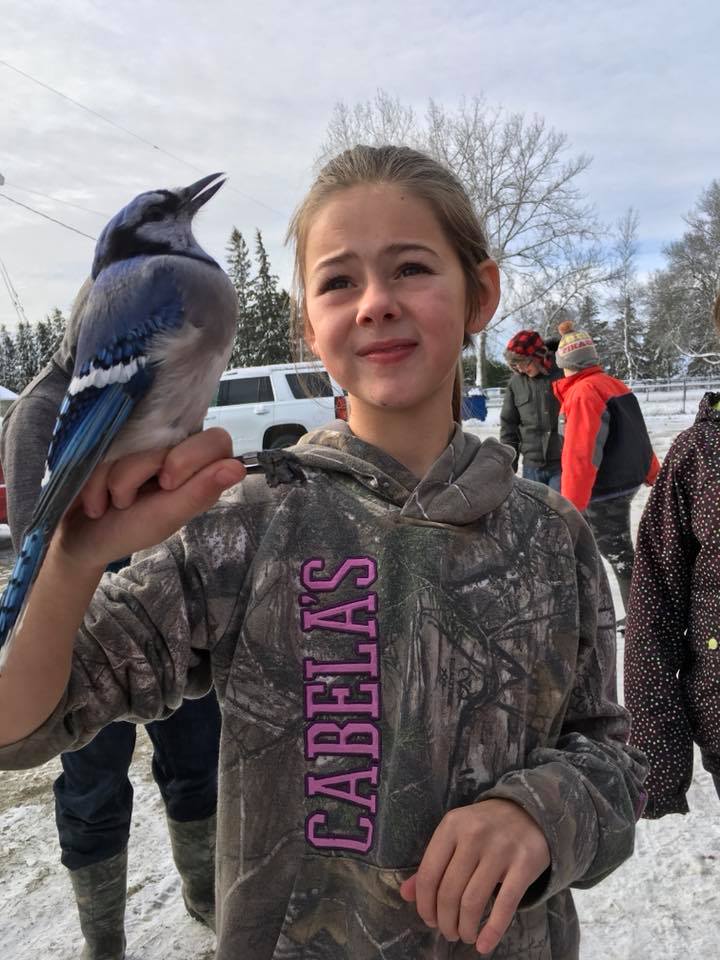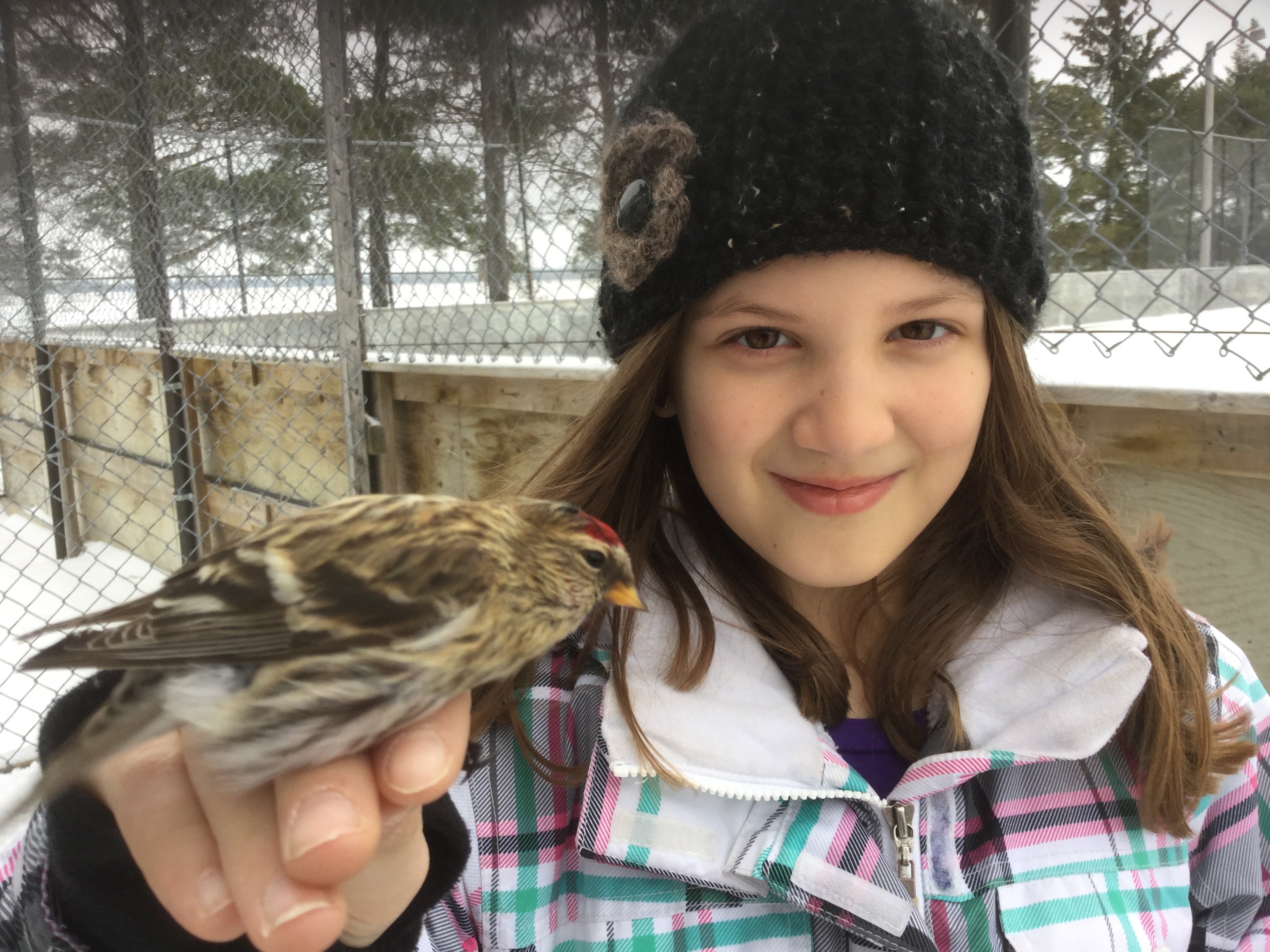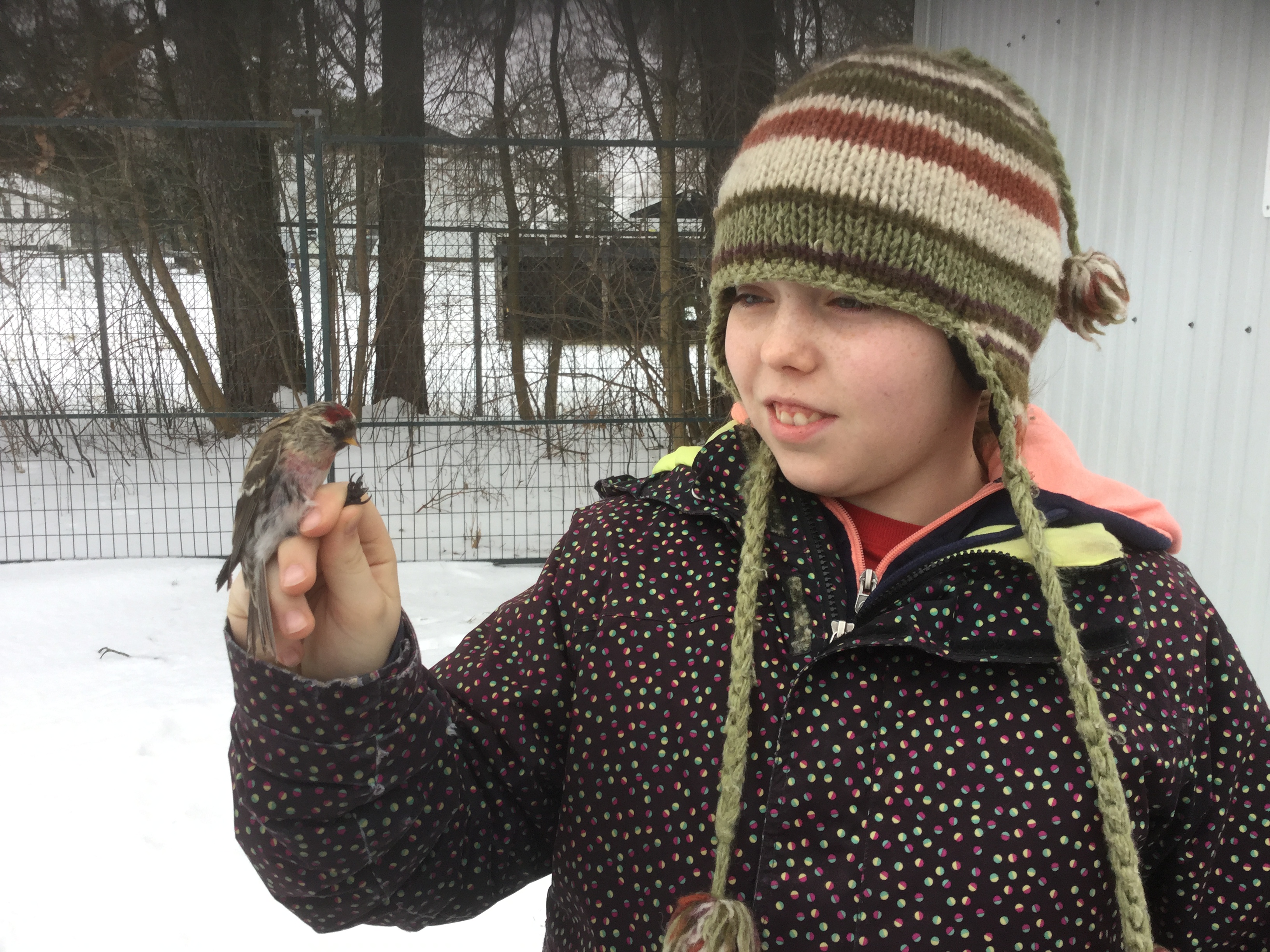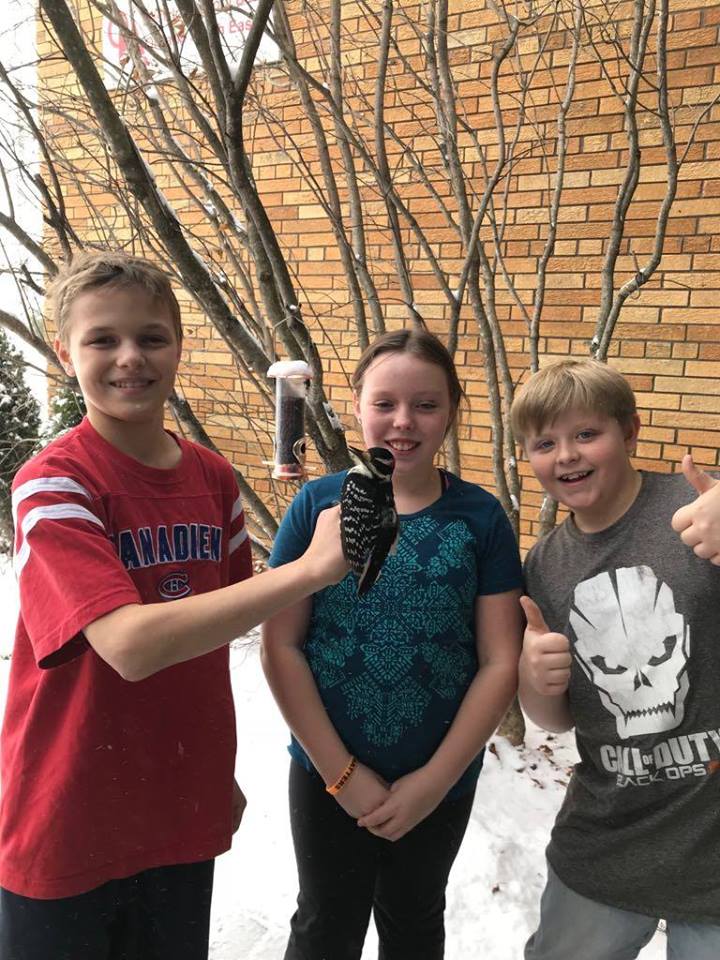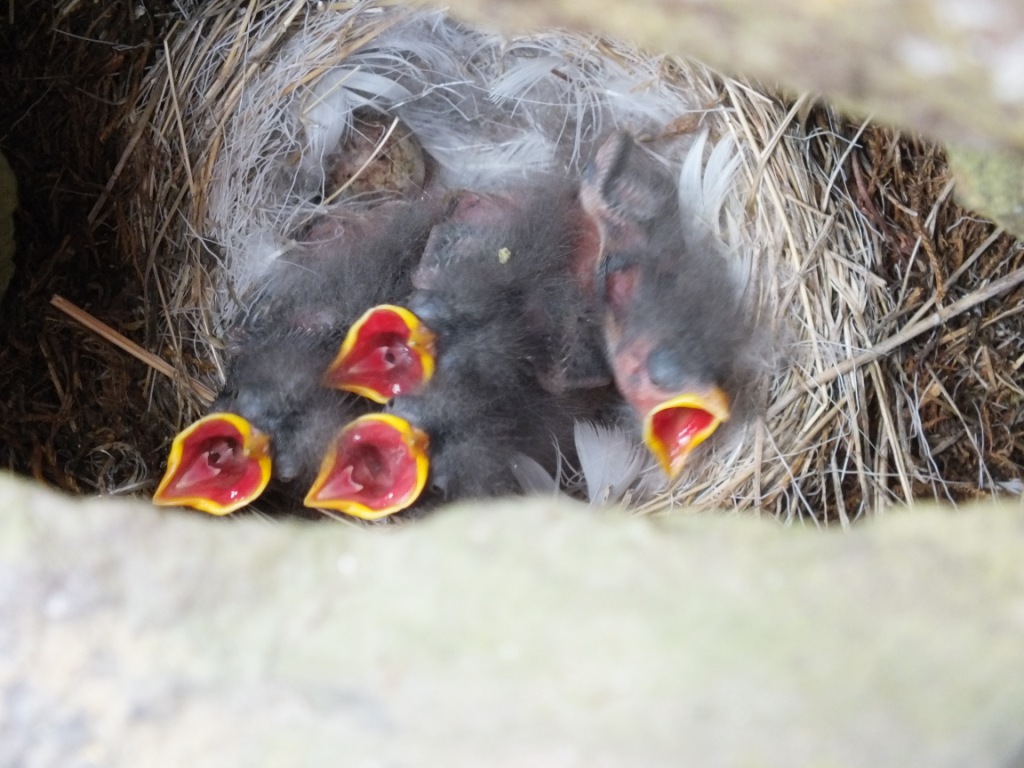We had a month of very cold temperatures with snow from about mid-December to mid-January. And we banded a lot of Snow Buntings (as well as good numbers of Horned Larks and Lapland Longspurs). And then it got mild with some rain. The snow disappeared and, along with it, the Snow Buntings. The presence of snow cover seems to be the common denominator determining whether we will see/catch Snow Buntings or not. Temperatures can fluctuate and we’ll catch them. But snow cover can’t vary – no snow = no buntings. It’s interesting how this theme crops up time and time again (eg, see the delightful description below from Brainard Palmer-Ball in Kentucky. It was actually his email to Oliver Love and I that inspired this posting. I just didn’t associate Kentucky with Snow Buntings (hmmm…..although I had recently gone looking for them in the Bahamas….)
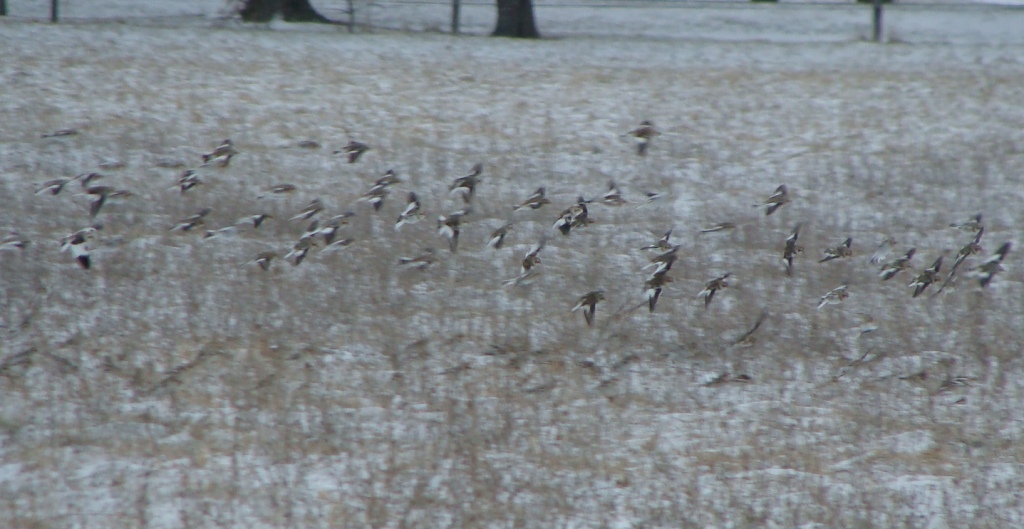
Just a small part of a (distant) flock of about 300 mostly female Snow Buntings further along Duxbury Road. One male sticks out on the far left.
In the middle of this past week the temperature dropped and we got a couple of centimeters of snow and…the Snow Buntings returned. On the 16th we banded 89 (along with single Horned Larks and Lapland Longspurs) and on the 18th we got another 36 (giving us a January total of 522). But now we’ve just lost the snow cover and there isn’t a Snow Bunting to be seen.
January 20, 2018
Hey, “snow bunting” is a sensitive topic around here!! Since December I have sighted a few small flocks near the school- very inconsistently- one day they are around, then they vanish for a couple weeks, then back to tease us again. Finally, about a week ago, a small group of about 40 found the corn at school, then we had rain and lost most of our snow cover and they disappeared and haven’t come back. Our weather has been extremely cold with very warm and rainy temperature breaks. We have very little snow this year, with lots of bare ground showing in the fields. Luckily a flock of CORE and PIGR have found our classroom feeder so that has been keeping the kids and I occupied for now! The Blue Jays and very friendly Hairy Woodpecker have been welcomed distractions as well. Perhaps we will see a rush of SNBU in the spring which is typically when we catch most of our birds anyway.
Joanne Goddard
Kerns Public School
New Liskeard, ON
[If you can’t catch Snow Buntings, here’s some others that are just about as good:]
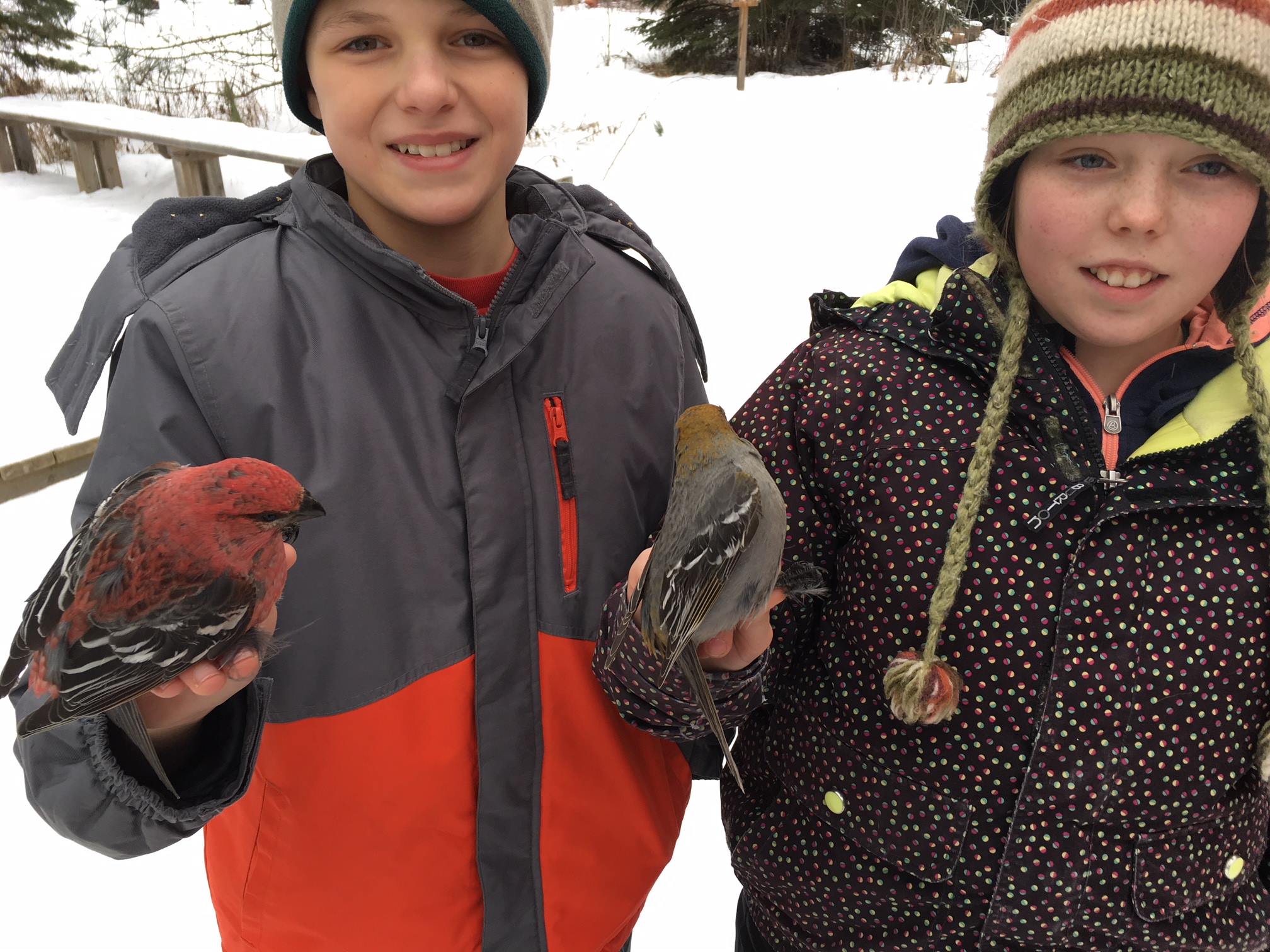
If you can’t get Snow Buntings then Pine Grosbeaks (male left; female right) are a great alternative. -J. Goddard
January 19, 2018
Six inches of snow last night and 11 snow buntings sitting in the tree they always sit in, waiting to be fed, for the first time this morning.
[In response to my email reply: “How neat is that!?”]
Ranks right up there with the middle of May when the tree swallows come back to the tree swallow nest box that has been occupied for the last 15 years. Sat empty for years, but once taken, there has been birds in it every year since (although the box itself has been upgraded several times!), or the third week of May, when my male bobolink shows up one morning sitting in “his” bush down on the marsh singing his heart out…. and, with any luck at all, the pair of barn swallows that successfully fledged 4 out of my barn last year after a 25 year absence, come back this year. And, if they were a first year pair, which they might be looking for new territory, maybe as a more mature pair have two broods this year. I had a neighbor that had a pair that raised two broods a year for years… Unfortunately one year one of the pair was hit by a car and died. The other bird left and the nest hasn’t been used for the last 5 years.
What was neat about the buntings was there was only four for a couple hours. Then one lifted, and flew a big circle out over the river, chirping, intercepted another small flock of 7 and circled them back to land in “their” tree.. I wonder if they were coming anyway, but it sure looked like she went out to lead them in….
And I heard my barred owl last night..
Sorry. I ramble.
Barb McLaughlin
283 McKay Siding Rd, McKay Siding NS
January 19th, 2018
Oliver & Rick,
Attached and pasted below is an account for SNBU in KY. It is interesting … just about every year we get a report of a single bunting or small flock during what must be a fall migratory period; those are the early dates listed below; however, we normally seen none unless there is a pretty good snow to our north. First we will get an influx of more Horned Larks including northern race; then we often get some larger flocks of Lapland Longspurs, maybe with a bunting or two in the mix, but then in extraordinary cases, we will get pure or nearly pure flocks of Snow Buntings. ALWAYS with snow on the ground; never if not, unless maybe it’s ice (frz rain). And just like clockwork, as soon as the snow disappears, so do the flocks of Snow Buntings. I have always figured they just follow the snow line north and south.
I absolutely love them, of course; they are always treasured to see. I also love their calls; the mellow rattle and twisting metallic notes.
A great bird to work with!
This week we’ve finally gotten snow and there are a tiny number some distance north of us. I’ve had Horned Larks on my farm where I had the 800 Snow Buntings in 1982 the past few days. A couple of Laps showed up with them yesterday and they were back this morning; then late morning, a flock of 65-70 Laps showed up suddenly and stayed the rest of the day with the 50 or so larks. One more snow and maybe we’d have gotten Snow Buntings, but the snow will melt next few days …
Thanks for being an audience for my ramblings ….
Brainard Palmer-Ball
Kentucky, USA
Fellas,
I forgot to mention one thing … sex ratios … in the big flocks, we do see males, but they are usually well outnumbered by females. I haven’t ever looked up HY male plumage, but the ones I know are males are the ones with all the big block of white in the wing, and they are typically well outnumbered by the female-types. I don’t think I’ve ever seen something I thought was a male in the early flight, but I’ve only seen 4 or 5 of them in Oct or Nov over the years.
Brainard
SNOW BUNTING Plectrophenax nivalis
Status:
Extremely rare to rare tran¬sient and winter visitant. Most older records originated at the Falls of the Ohio and more recently in open farmland near Louisville, but there are ¬now a number of widely scattered records from across the state, including at least two records from the Cum¬ber¬land Plateau (see Boyd and Elliott cos. below). This species is occasionally seen along open shores of the larger lakes and rivers, but more frequently in grain stubble fields with Horned Larks and Lapland Longspurs. Usually encountered in small numbers of up to a dozen or so birds, but larger flocks of a hundred or more individuals have been observed on a few occasions.
County records:
Adair (R. Denton, 1996 notes; KW 85:53, 2009);
Boone (KW 70:37, 1994; KW 75:27, 1999; B. Palmer-Ball, 2000 notes; KW 80:48, 2004; KW 83:52, 2007; KW 84:71, 2008; KW 85:53, 2009; KW 90:54, 2014);
Bourbon (KW 90:54, 2014);
Boyd Co. (KW 35:10, 1959);
Bracken (KW 83:52, 2007);
Calloway (KW 86:47, 2010);
Campbell (Mengel:515; KW 75:27, 1999; KW 80:48, 2004);
Carroll (KW 67:9, 1991);
Christian (KW 59:9, 1983);
Daviess (KW 77:17, 2001);
Elliott Co. (Greene, KW 54:14, 1978; KW 85:53, 2009);
Fayette (KW 58:31, 1982; KW 85:53, 2009; KW 87:64, 2011; KW 90:54, 2014);
Franklin (A. Gilchrist, pers. comm.; fide A. Stamm notes; KW 85:53, 2009; KW 86:47, 2010);
Jefferson (numerous reports);
Gallatin (KW 83:52, 2007; KW 90:54, 2014);
Grant (Davis, KW 40:33, 1964);
Harrison (KW 90:54, 2014);
Henderson (KW 90:54, 2014);
Lewis (KW 86:47, 2010; KW 87:64, 2011);
Lincoln (KW 85:53, 2009);
Lyon (KW 85:53, 2009);
Marion (Webster, KW 37:18, 1961);
Marshall (Mengel:515 [location given as Kentucky Lake therein]; B. Palmer-Ball, 1995 notes; KW 77:17, 2001 [location given as Land Between the Lakes CBC therein]; KW 85:53, 2009);
Meade (KW 77:17, 2001);
Muhlenberg (KW 66:18/41, 1990);
Ohio (KW 79:49, 2003);
Oldham (numerous reports just outside of Louisville; KW 90:54, 2014);
Pulaski (KW 85:53, 2009);
Rowan (KW 78:13, 2002/L. Kornman, photograph; KW 83:52, 2007; KW 85:53, 2009; KW 89:53, 2013);
Russell (KW 85:53, 2009);
Shelby (KW 54:31, 1978; KW 60:11, 1984; KW 63:12, 1987; KW 65:12, 1989; KW 77:30, 2001; KW 87:64, 2011);
Spencer (KW 85:53, 2009);
Union (KW 91:13, 2015);
Warren (KW 75:27, 1999; D. Roemer, 2000 videotape/notes; KW 79:49, 2003)
Wayne (KW 85:53, 2009);
Woodford (KW 85:53, 2009).
Maximum counts: 750+ in one flock near Louisville, 10 Feb 1982 (B. Palmer-Ball, photo-graphs/notes¬¬¬ [number incorrectly published¬ as “400” in KW 58:31, 1982]); ca. 200 in Jefferson Co., 12 Dec 1977 (KW 54:31, 1978); 75-80 in ne. Jefferson Co., 1 Feb 2004 (KW 80:48, 2004); ca. 70 in Fayette Co, 5-6 Feb 2009 (KW 85:53, 2009); 60 in Boone Co., 19 Feb 2007 (KW 83:52, 2007); 51 in Jefferson Co., 28 Jan 2009 (KW 85:53, 2009).
Late spring date: 8 Mar 1978, Jefferson Co. (KW 54:47, 1978).
Early fall dates: 23 Oct 1977, Elliott Co. (Greene, KW 54:14, 1978); 24 Oct 2014, Union Co. (KW 91:13, 2015); 8 Nov 1975, Frankfort Fish Hatchery (A. Gilchrist, pers. comm.; fide A. Stamm, notes); 12 Nov 1944, Kentucky Lake area (Men¬gel:515); 12 Nov 2006, Falls of the Ohio (KW 83:20, 2007).
Unaccepted records: 4-9 Oct 1965, Ft. Knox (AFN 20:54, 1966; KW 52:64, 1976) [I cannot find any details of this observation and feel it best be listed here]; Mengel (p. 516) includes a few other vague historical references
Life History Pictures:



